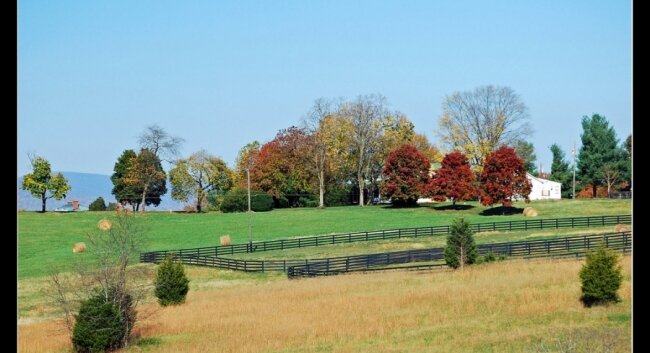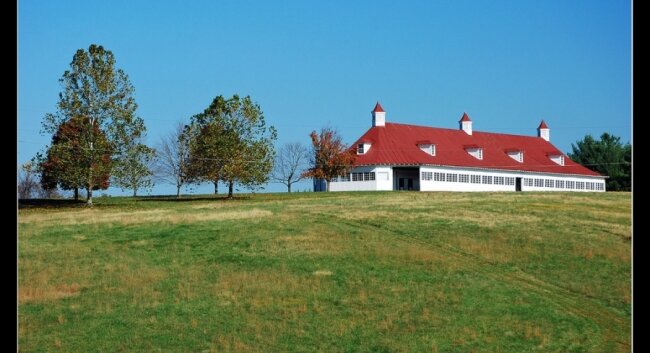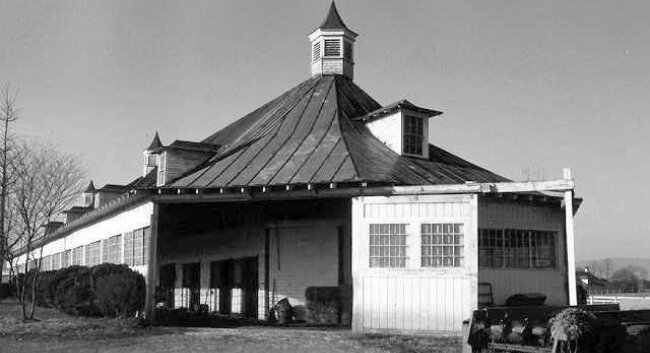Preservationists 'speechless': Pre-permit Ingleside demolition raises ire
-
 Ingleside Farm off of Garth Road just west of town. The demolished farmhouse there was renovated by architect Floyd Johnson, but was never documented.Photo by Stephen Brown / sjb4photos on flickr.com.
Ingleside Farm off of Garth Road just west of town. The demolished farmhouse there was renovated by architect Floyd Johnson, but was never documented.Photo by Stephen Brown / sjb4photos on flickr.com. -
 This circa 1935 barn, one of several 'grand barns" built along Garth Road, was home to at least one Kentucky Derby winning horse.Photo by Stephen Brown / sjb4photos on flickr.com.
This circa 1935 barn, one of several 'grand barns" built along Garth Road, was home to at least one Kentucky Derby winning horse.Photo by Stephen Brown / sjb4photos on flickr.com. -
 The Ingleside Farm barnPhoto courtesy K. Edward Lay
The Ingleside Farm barnPhoto courtesy K. Edward Lay
It sounds like a joke.
"I tell ya, the county's historic preservation codes are so weak," the comedian says, "you can apply for a demo permit after you've demolished your old house." Bada-boom!
But it's no joke.
Recently, when County historic resources planner Margaret Maliszewski received a demolition permit for the house at Ingleside Farm on Garth Road, she wanted to save or at least document the two-story, circa 1938 structure that had been mostly recently renovated by renowned local architect Floyd Johnson. When Maliszewski called the contractor to confer about what she thought was an upcoming demolition, she was informed that the house had already been taken down.
"We estimate that two or three buildings were demolished in the past two years before the permit was approved," says Maliszewski.
And those are the ones they know about.
"We have no system for tracking the number of buildings that are demolished without permits," she says.
The County's Historic Preservation Committee supports the documentation of historic structures prior to demolition, and tries to do as many as they can each year, but when property owners choose to demo places on their own, there's little the County can do.
"The Committee was speechless upon learning of its demise," says committee member Steven Meeks of the Ingleside farmhouse, "because we had no opportunity to document the structure before it was destroyed."
Indeed, there's little official information about the 3,400 square-foot house, the former centerpiece of a 131-acre farm, as Meeks says the structure was never documented by the Virginia Department of Historic Resources. However, the papers of architect Floyd Johnson located in UVA's Special Collection library reveal that Johnson worked on the farmhouse in the mid-1980s when it was owned by electronics merchandiser Bill Crutchfield and his then wife, Jana.
Property records indicate that Ms. Crutchfield became the sole owner of Ingleside Farm in 2004 and its horse-training facility, complete with a 132,000 square-foot race track and a historic 5,000 square-foot horse barn, along with six other outbuildings. Ms. Crutchfield lives just across Garth in a $900,000 home on a nearby cul-de-sac.
According to UVA architectural historian Ed Lay, the barn was built 1935, a fine example of a number of "grand barns" that were built on Garth Road in the earlier twentieth century. Gentleman farmer William Garth, whose family owned the Birdwood Estate (and for whom the road was named), was a famous horse trainer at the time. According to John Hammond Moore's Albemarle, Garth "trained more winners in 1906 than any other man in America."
The demolished house, says Lay, was later built by a Lynchburg architect name C. L. Lewis for Garth's son-in-law, Dr. J.P. Jones. Another Jones, a horse named Paul Jones, winner of the 1920 Kentucky Derby, was owned by Garth and is apparently buried somewhere at Ingleside Farm. Meridian, winner of the 1911 Kentucky Derby, was also owned by Garth.
So why was the farm house demolished? While messages left at Ms. Crutchfield's home went unreturned, Maliszewski says the demo appears to have made room for new construction on the site.
"While we're all saddened to see this happen, most everyone agrees the owner has the right to do this," says Meeks. "What we would like is the opportunity to document the structure, talk with the property owner, and possibly offer other alternatives and allow for the chance to salvage."
"I've been in favor of a historic preservation ordinance which would document procedures with more significant impact," says supervisor Ann Mallek. "This does not mean that all old buildings must be kept but that the most valuable ones would get documentation and owners would get assistance as to how to care for them."
Of course, County leaders have been saying this for more than a decade. In August 2000, Planning Commission members expressed concern about a development called southeast of town on the site of a once-bustling shipping village.
Founded on the Rivanna River in 1789, the town of Milton emerged as a key early Albemarle depot because, according to Moore's Albemarle, it was the last navigable stretch of waterway before "The Shallows" prevented larger Richmond-based boats from reaching Charlottesville.
According to an August 23, 2000 story in the Daily Progress, when Milton-area landowner William Orr (who recently weighed in the demo of the old Manse at the historic South Plains Presbyterian Church) proposed a 63-acre development on the site, historic preservationists, archeologists, and Commission members expressed outrage. But there was nothing they could do. Commissioners had just recommended adoption of the Historic Preservation Plan designed to preserve or document such places.
“We do not have the discretion, legally, to turn this subdivision down, much as I would like to,” said then Commissioner Dennis Rooker.
Then Commissioner William Rieley called it a "classic case of why we need a historic preservation ordinance badly” and why a voluntary ordinance is "inadequate.”
However, over ten years later, the Historic Preservation Plan still languishes, spineless.
Meeks says the Historic Preservation Committee wants the story of the Ingleside Farm House demo to come before the Board of Supervisors, and that this pattern of applying for after-the-fact demolition permits deserves further study.
"This is a house no one ever believed would ever meet this fate," says Meeks.
Correction 7/18/2011: The Crutchfeilds purchased the farm property in 1993, therefore architect Floyd Johnson's work in the 1980s was done for a previous owner of the farm house.
We've also confirmed that the large horse barn on the property was actually located on property across the the street owned by Jack Sanford of Faulconer Construction, but was dismantled and moved to the Ingleside Farm property when that property was developed.
8 comments
In the 60s it was said that once Mrs. Dr. Jones died the main bulwark against development would be gone on the Garth road. Now her whole place is McMansion heaven. The old 30s house I guess didn't fit in with the new McMansions.
I heard there used to be cockfights in those barns (a long
time ago of course).
yeah, mer, and the south used to have slaves, so move on!
I'm from the North, so I have to ask (Ann Smith)...did they still have slaves on this property in the 1930s??? Hey Mer...thanks for the interesting sidenote!!! y'all have a nice day...
The big barn on the hill used to be on the other side of the road! I saw it being moved many years ago and it was very amazing.I don't know who owned the property when the barn was moved. I believe it was moved to put in the subdivision. The barn in the black and white picture above no longer exists. It was there not long ago but was removed. I'd like to see the big barn saved. It would be a sad day to see that knocked down as the house was. It is a beautiful building. Someone cared enough for it once to move it maybe someone will care enough now to protect it.
That's right. Quite a few blacks moved on didn't they
after the so called Massive Resistance for example. PE Co closed
public schools for 7 years. A textbook case used all over
the world. People who forget history etc.
cockfighting should not have been felonized.To compare it to dogfighting is bogus.
I have lived in Albe co all my life. Its sad to see white trash buy these old farms and distroy them like they are doing. I know this farm and it was a great farm in its day. Yes the last barn standing on the north side of Garth Rd was on the south side but was moved in the early 80's in four pieces. The barn that was broadside to Garth Rd was torn down in the late 80's or early 90's. These old barns were Sears barn's. There is no respect to history from these A-Holes who buy these farms. There was no really good reason to take down the house or the barn becuase it was a sound house and they could have or could build their house on some other part of the place.
I have to agree with others that the damn white trash yankee's need to stay up north and leave us southerns alone and our history alone.
I have pic's of the farm before the houses were built on the south side of Garth Rd.